VAUXHALL ZAFIRA 2014 Owner's Manual
Manufacturer: VAUXHALL, Model Year: 2014, Model line: ZAFIRA, Model: VAUXHALL ZAFIRA 2014Pages: 217, PDF Size: 7.85 MB
Page 171 of 217
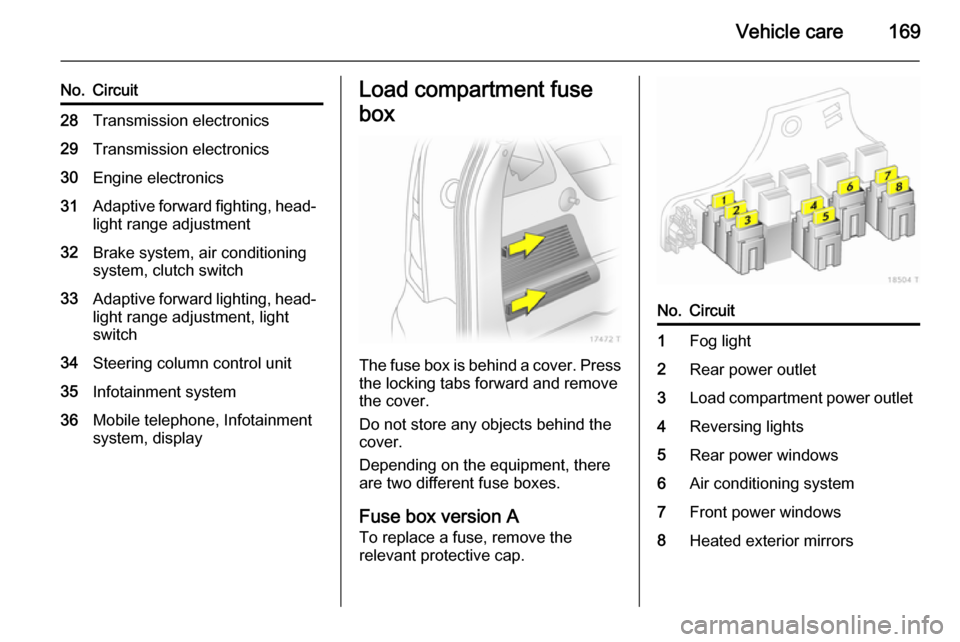
Vehicle care169
No.Circuit28Transmission electronics29Transmission electronics30Engine electronics31Adaptive forward fighting, head‐light range adjustment32Brake system, air conditioning
system, clutch switch33Adaptive forward lighting, head‐
light range adjustment, light
switch34Steering column control unit35Infotainment system36Mobile telephone, Infotainment
system, displayLoad compartment fuse
box
The fuse box is behind a cover. Press
the locking tabs forward and remove
the cover.
Do not store any objects behind the
cover.
Depending on the equipment, there
are two different fuse boxes.
Fuse box version A
To replace a fuse, remove the
relevant protective cap.
No.Circuit1Fog light2Rear power outlet3Load compartment power outlet4Reversing lights5Rear power windows6Air conditioning system7Front power windows8Heated exterior mirrors
Page 172 of 217
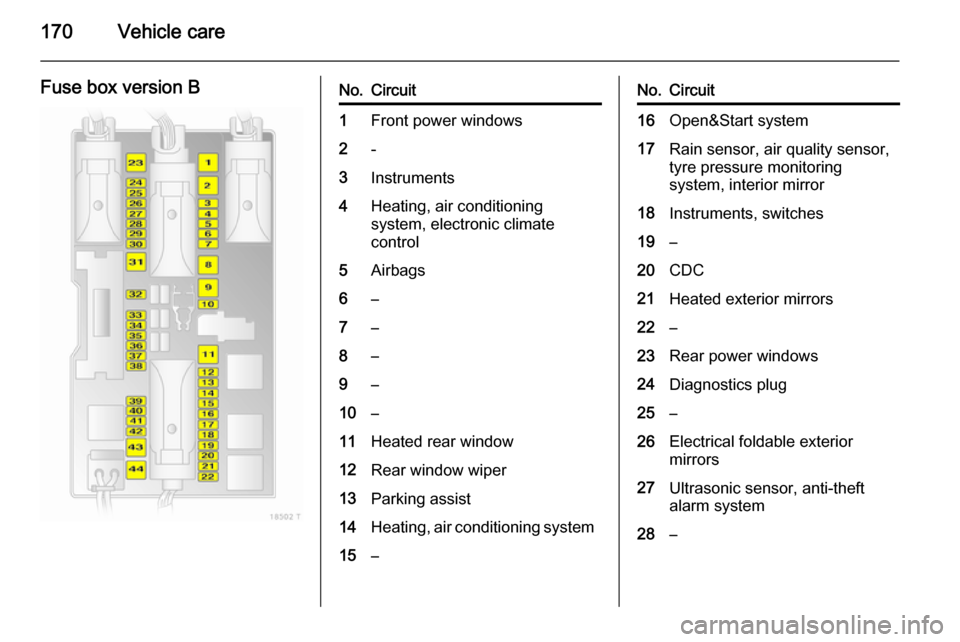
170Vehicle care
Fuse box version BNo.Circuit1Front power windows2-3Instruments4Heating, air conditioning
system, electronic climate
control5Airbags6–7–8–9–10–11Heated rear window12Rear window wiper13Parking assist14Heating, air conditioning system15–No.Circuit16Open&Start system17Rain sensor, air quality sensor,
tyre pressure monitoring
system, interior mirror18Instruments, switches19–20CDC21Heated exterior mirrors22–23Rear power windows24Diagnostics plug25–26Electrical foldable exterior
mirrors27Ultrasonic sensor, anti-theft
alarm system28–
Page 173 of 217
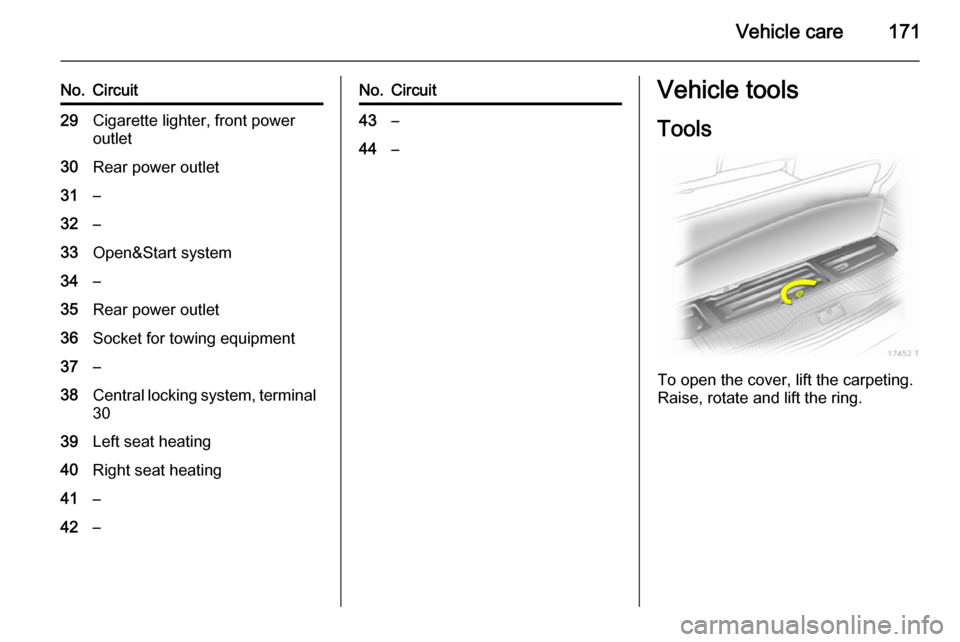
Vehicle care171
No.Circuit29Cigarette lighter, front power
outlet30Rear power outlet31–32–33Open&Start system34–35Rear power outlet36Socket for towing equipment37–38Central locking system, terminal
3039Left seat heating40Right seat heating41–42–No.Circuit43–44–Vehicle tools
Tools
To open the cover, lift the carpeting.
Raise, rotate and lift the ring.
Page 174 of 217
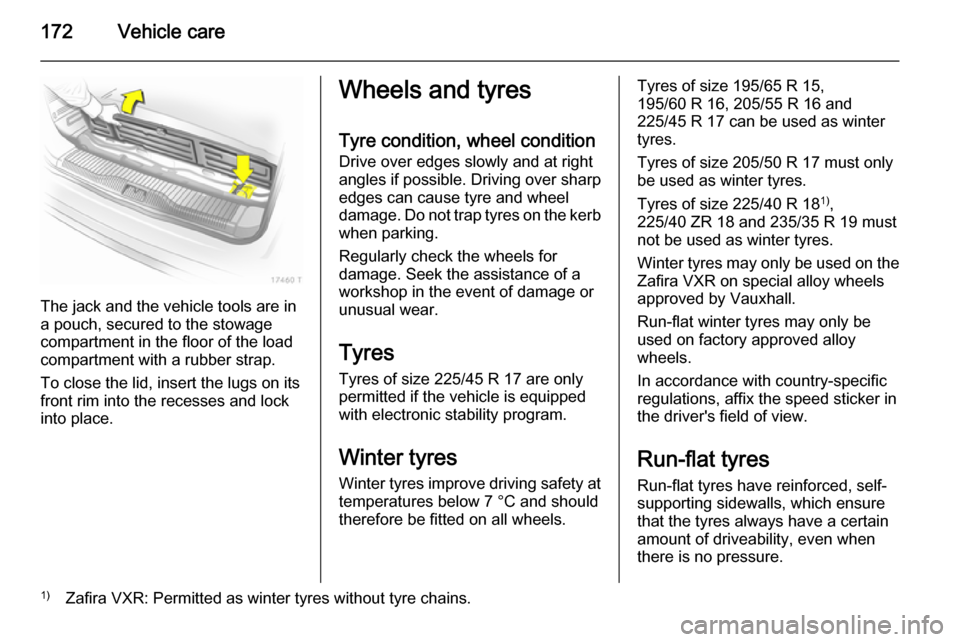
172Vehicle care
The jack and the vehicle tools are in
a pouch, secured to the stowage
compartment in the floor of the load
compartment with a rubber strap.
To close the lid, insert the lugs on its
front rim into the recesses and lock
into place.
Wheels and tyres
Tyre condition, wheel condition
Drive over edges slowly and at right
angles if possible. Driving over sharp
edges can cause tyre and wheel
damage. Do not trap tyres on the kerb when parking.
Regularly check the wheels for
damage. Seek the assistance of a
workshop in the event of damage or
unusual wear.
Tyres
Tyres of size 225/45 R 17 are only permitted if the vehicle is equipped
with electronic stability program.
Winter tyres
Winter tyres improve driving safety at temperatures below 7 °C and should
therefore be fitted on all wheels.Tyres of size 195/65 R 15,
195/60 R 16, 205/55 R 16 and
225/45 R 17 can be used as winter
tyres.
Tyres of size 205/50 R 17 must only
be used as winter tyres.
Tyres of size 225/40 R 18 1)
,
225/40 ZR 18 and 235/35 R 19 must not be used as winter tyres.
Winter tyres may only be used on the
Zafira VXR on special alloy wheels
approved by Vauxhall.
Run-flat winter tyres may only be
used on factory approved alloy
wheels.
In accordance with country-specific
regulations, affix the speed sticker in
the driver's field of view.
Run-flat tyres Run-flat tyres have reinforced, self-
supporting sidewalls, which ensure
that the tyres always have a certain
amount of driveability, even when
there is no pressure.1) Zafira VXR: Permitted as winter tyres without tyre chains.
Page 175 of 217
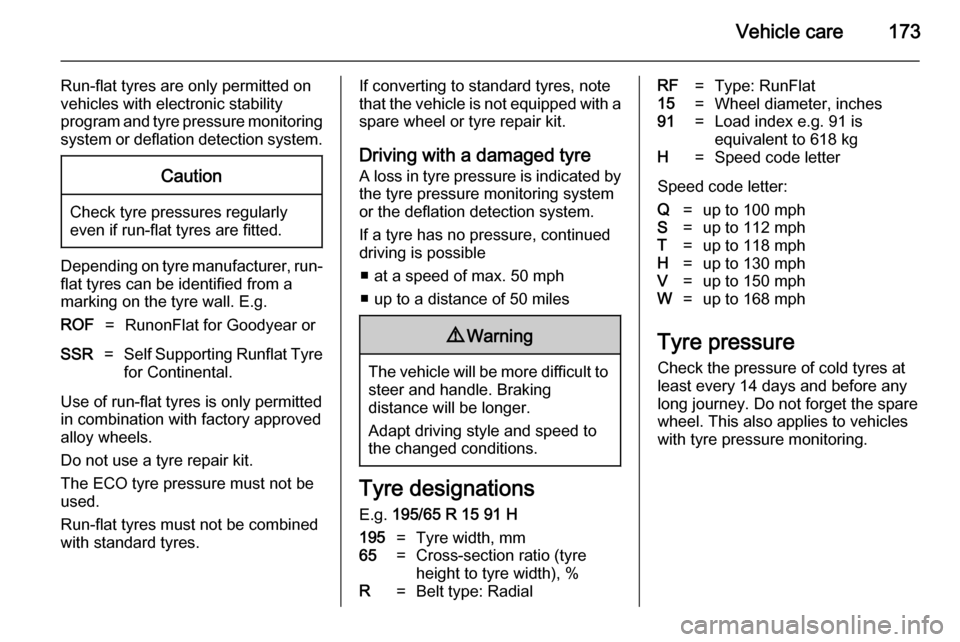
Vehicle care173
Run-flat tyres are only permitted on
vehicles with electronic stability
program and tyre pressure monitoring
system or deflation detection system.Caution
Check tyre pressures regularly
even if run-flat tyres are fitted.
Depending on tyre manufacturer, run-
flat tyres can be identified from a
marking on the tyre wall. E.g.
ROF=RunonFlat for Goodyear orSSR=Self Supporting Runflat Tyre
for Continental.
Use of run-flat tyres is only permitted
in combination with factory approved
alloy wheels.
Do not use a tyre repair kit.
The ECO tyre pressure must not be
used.
Run-flat tyres must not be combined
with standard tyres.
If converting to standard tyres, note
that the vehicle is not equipped with a spare wheel or tyre repair kit.
Driving with a damaged tyre
A loss in tyre pressure is indicated by
the tyre pressure monitoring system
or the deflation detection system.
If a tyre has no pressure, continued
driving is possible
■ at a speed of max. 50 mph
■ up to a distance of 50 miles9 Warning
The vehicle will be more difficult to
steer and handle. Braking
distance will be longer.
Adapt driving style and speed to the changed conditions.
Tyre designations
E.g. 195/65 R 15 91 H
195=Tyre width, mm65=Cross-section ratio (tyre
height to tyre width), %R=Belt type: RadialRF=Type: RunFlat15=Wheel diameter, inches91=Load index e.g. 91 is
equivalent to 618 kgH=Speed code letter
Speed code letter:
Q=up to 100 mphS=up to 112 mphT=up to 118 mphH=up to 130 mphV=up to 150 mphW=up to 168 mph
Tyre pressure
Check the pressure of cold tyres at
least every 14 days and before any
long journey. Do not forget the spare
wheel. This also applies to vehicles
with tyre pressure monitoring.
Page 176 of 217
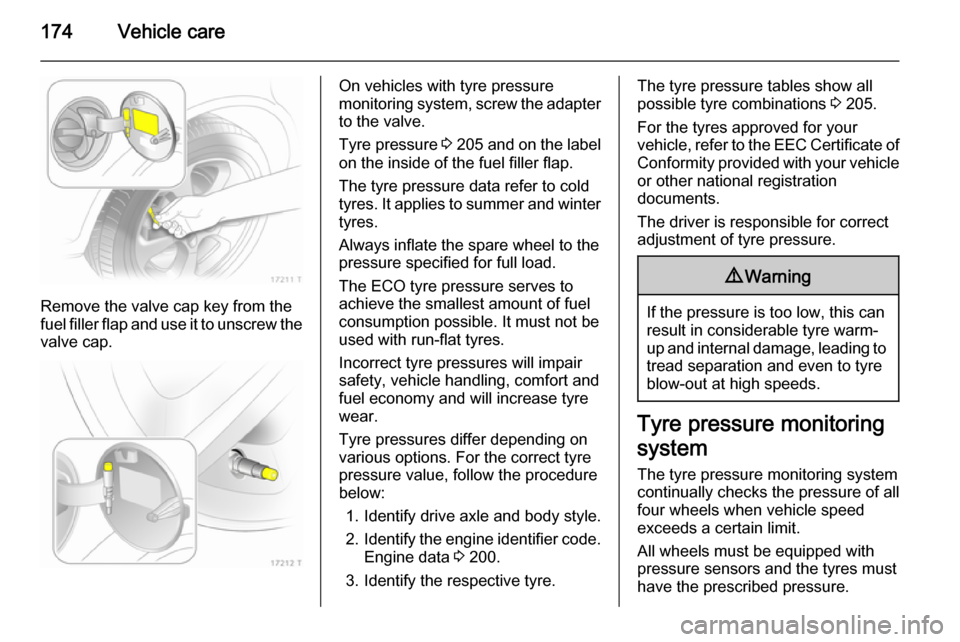
174Vehicle care
Remove the valve cap key from the
fuel filler flap and use it to unscrew the
valve cap.
On vehicles with tyre pressure
monitoring system, screw the adapter
to the valve.
Tyre pressure 3 205 and on the label
on the inside of the fuel filler flap.
The tyre pressure data refer to cold
tyres. It applies to summer and winter tyres.
Always inflate the spare wheel to the
pressure specified for full load.
The ECO tyre pressure serves to
achieve the smallest amount of fuel
consumption possible. It must not be used with run-flat tyres.
Incorrect tyre pressures will impair
safety, vehicle handling, comfort and
fuel economy and will increase tyre
wear.
Tyre pressures differ depending on
various options. For the correct tyre
pressure value, follow the procedure
below:
1. Identify drive axle and body style.
2. Identify the engine identifier code.
Engine data 3 200.
3. Identify the respective tyre.The tyre pressure tables show all
possible tyre combinations 3 205.
For the tyres approved for your
vehicle, refer to the EEC Certificate of
Conformity provided with your vehicle
or other national registration
documents.
The driver is responsible for correct
adjustment of tyre pressure.9 Warning
If the pressure is too low, this can
result in considerable tyre warm-
up and internal damage, leading to tread separation and even to tyre
blow-out at high speeds.
Tyre pressure monitoring
system
The tyre pressure monitoring system
continually checks the pressure of all
four wheels when vehicle speed
exceeds a certain limit.
All wheels must be equipped with
pressure sensors and the tyres must
have the prescribed pressure.
Page 177 of 217
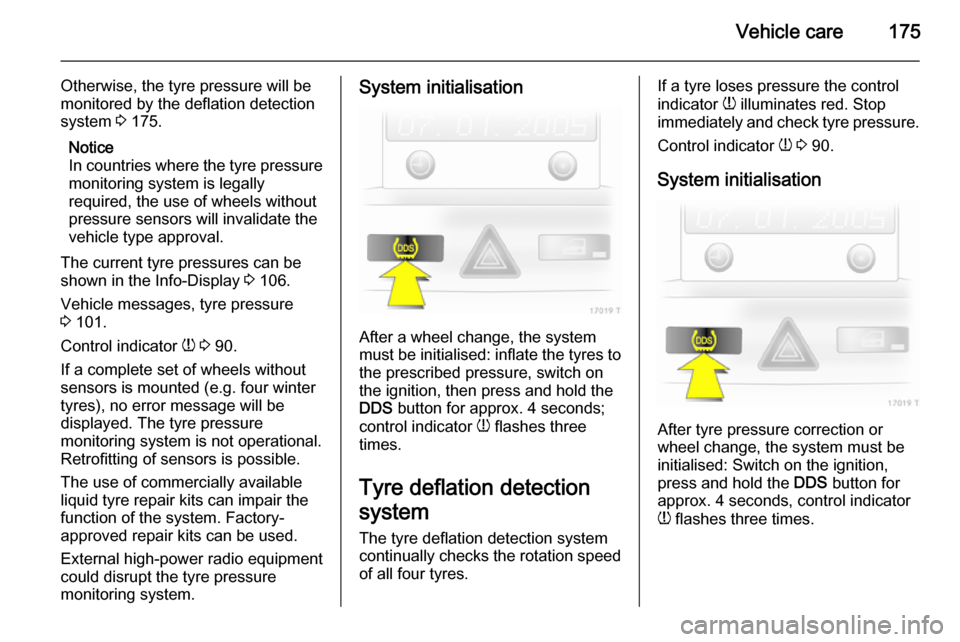
Vehicle care175
Otherwise, the tyre pressure will be
monitored by the deflation detection
system 3 175.
Notice
In countries where the tyre pressure
monitoring system is legally
required, the use of wheels without
pressure sensors will invalidate the
vehicle type approval.
The current tyre pressures can be
shown in the Info-Display 3 106.
Vehicle messages, tyre pressure
3 101.
Control indicator w 3 90.
If a complete set of wheels without
sensors is mounted (e.g. four winter
tyres), no error message will be
displayed. The tyre pressure
monitoring system is not operational.
Retrofitting of sensors is possible.
The use of commercially available
liquid tyre repair kits can impair the
function of the system. Factory-
approved repair kits can be used.
External high-power radio equipment
could disrupt the tyre pressure
monitoring system.System initialisation
After a wheel change, the system
must be initialised: inflate the tyres to
the prescribed pressure, switch on
the ignition, then press and hold the
DDS button for approx. 4 seconds;
control indicator w flashes three
times.
Tyre deflation detection
system
The tyre deflation detection system
continually checks the rotation speed
of all four tyres.
If a tyre loses pressure the control
indicator w illuminates red. Stop
immediately and check tyre pressure.
Control indicator w 3 90.
System initialisation
After tyre pressure correction or
wheel change, the system must be
initialised: Switch on the ignition,
press and hold the DDS button for
approx. 4 seconds, control indicator
w flashes three times.
Page 178 of 217
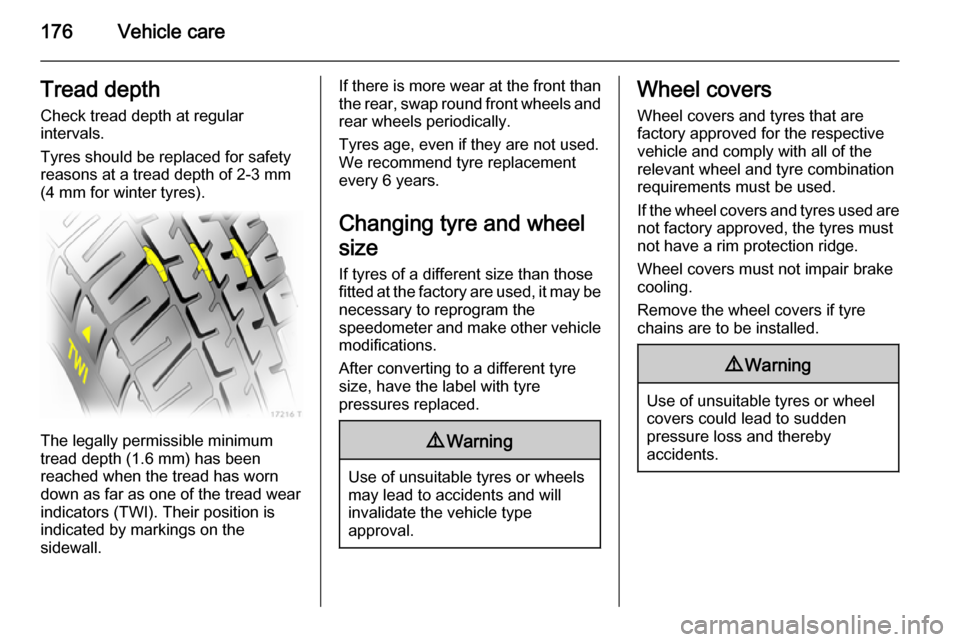
176Vehicle careTread depth
Check tread depth at regular
intervals.
Tyres should be replaced for safety
reasons at a tread depth of 2-3 mm
(4 mm for winter tyres).
The legally permissible minimum
tread depth (1.6 mm) has been
reached when the tread has worn
down as far as one of the tread wear
indicators (TWI). Their position is
indicated by markings on the
sidewall.
If there is more wear at the front than
the rear, swap round front wheels and rear wheels periodically.
Tyres age, even if they are not used.
We recommend tyre replacement
every 6 years.
Changing tyre and wheel
size If tyres of a different size than those
fitted at the factory are used, it may be necessary to reprogram the
speedometer and make other vehicle
modifications.
After converting to a different tyre
size, have the label with tyre
pressures replaced.9 Warning
Use of unsuitable tyres or wheels
may lead to accidents and will
invalidate the vehicle type
approval.
Wheel covers
Wheel covers and tyres that are
factory approved for the respective
vehicle and comply with all of the
relevant wheel and tyre combination requirements must be used.
If the wheel covers and tyres used are
not factory approved, the tyres must
not have a rim protection ridge.
Wheel covers must not impair brake
cooling.
Remove the wheel covers if tyre
chains are to be installed.9 Warning
Use of unsuitable tyres or wheel
covers could lead to sudden
pressure loss and thereby
accidents.
Page 179 of 217
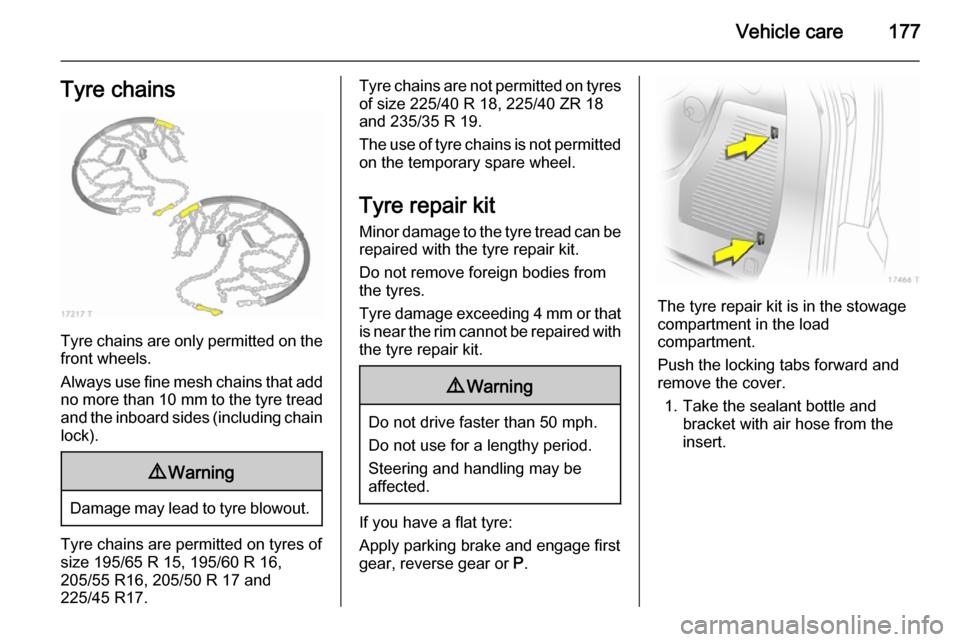
Vehicle care177Tyre chains
Tyre chains are only permitted on the
front wheels.
Always use fine mesh chains that add no more than 10 mm to the tyre tread
and the inboard sides (including chain lock).
9 Warning
Damage may lead to tyre blowout.
Tyre chains are permitted on tyres of
size 195/65 R 15, 195/60 R 16,
205/55 R16, 205/50 R 17 and
225/45 R17.
Tyre chains are not permitted on tyres of size 225/40 R 18, 225/40 ZR 18
and 235/35 R 19.
The use of tyre chains is not permitted on the temporary spare wheel.
Tyre repair kit
Minor damage to the tyre tread can be
repaired with the tyre repair kit.
Do not remove foreign bodies from
the tyres.
Tyre damage exceeding 4 mm or that
is near the rim cannot be repaired with the tyre repair kit.9 Warning
Do not drive faster than 50 mph.
Do not use for a lengthy period.
Steering and handling may be
affected.
If you have a flat tyre:
Apply parking brake and engage first
gear, reverse gear or P.
The tyre repair kit is in the stowage
compartment in the load
compartment.
Push the locking tabs forward and
remove the cover.
1. Take the sealant bottle and bracket with air hose from the
insert.
Page 180 of 217
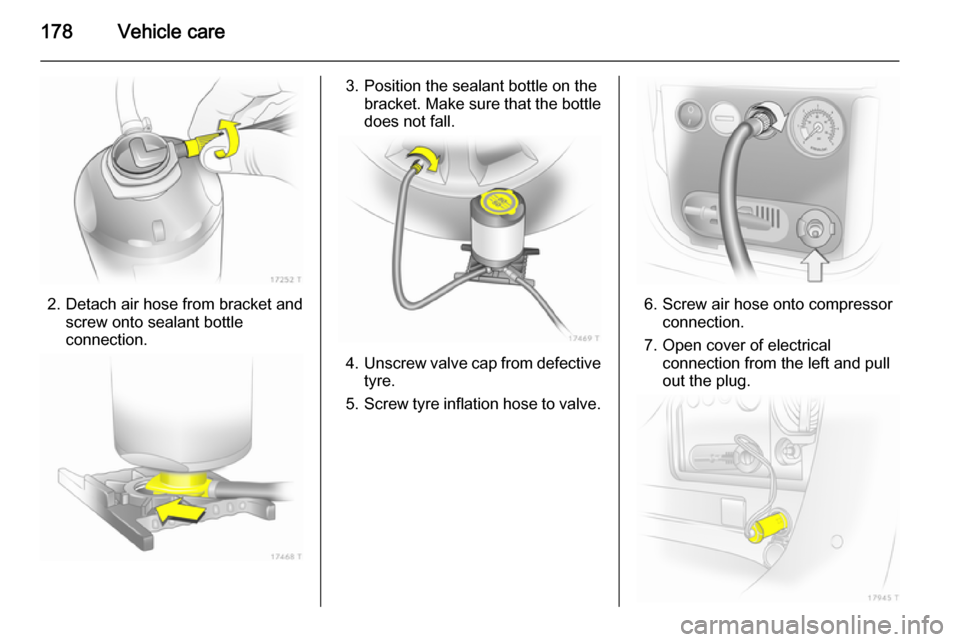
178Vehicle care
2. Detach air hose from bracket andscrew onto sealant bottle
connection.
3. Position the sealant bottle on the bracket. Make sure that the bottle
does not fall.
4. Unscrew valve cap from defective
tyre.
5. Screw tyre inflation hose to valve.
6. Screw air hose onto compressor
connection.
7. Open cover of electrical connection from the left and pull
out the plug.